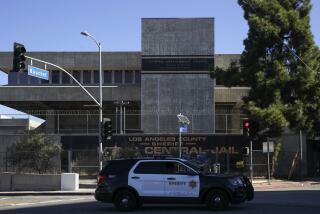Supervisors to Weigh Plan for Arraignments Via Video at Central Jail
- Share via
SANTA ANA — County officials want to shelve a controversial plan to construct a courtroom within the Central Men’s Jail complex, but a pilot program using video equipment to connect judges to jailed defendants may be operating by next week.
The video plan will be considered by the Board of Supervisors next week. It would involve using $120,000 worth of equipment and a studio in the Intake-Release Center at the Central Men’s Jail, and would eliminate the need to transport misdemeanor defendants via bus to county courthouses for arraignments.
“It would certainly create some savings, probably a couple thousand here and there for transportation, but the significant improvement is from the efficiency standpoint,” said Ron Coley, the county administrative manager of criminal justice matters.
The two-way video connection would eliminate a host of security problems involved in busing prisoners to and from court, and it would alleviate crowding problems by speeding up the release of some inmates, Coley said.
But the often-discussed idea of converting a jailhouse storage area to a full-time courtroom was deemed too costly and impractical in a report by the county Alternatives to Incarceration Task Force. The task force will present its findings to the Board of Supervisors on Tuesday.
That same panel endorsed the construction idea--first suggested in Orange County in 1983--last year. The plan, however, met with disapproval from municipal judges in the county’s north district, who questioned the proposal’s savings. After intense scrutiny of the plan, the task force agreed with the judges and recommended that the supervisors reject the idea.
“The task force concluded that construction of an in-jail courtroom would be imprudent until the advantages of having such a facility are more compelling,” the report states.
The task force, created by the Board of Supervisors to identify methods of easing prisoner crowding, reported that the video plan would be the most direct way to simplify and streamline the jail’s daily transport of inmates to their arraignments.
About 500 jail inmates are shuttled to the courts for arraignments and other proceedings each day.
The report also notes that 60% of maximum-security escapes from the Orange County sheriff’s custody occur during prisoner transfers.
Each morning, new inmates are taken before a judge for arraignment, the court proceeding in which an individual charged with a crime enters a plea.
In many misdemeanor cases, an inmate may be allowed to go free after the court appearance. Much of the logjam occurs while prisoners wait for the day’s arraignments to be completed. All prisoners on a bus must be arraigned before they can be taken back to the Intake-Release Center.
Eliminating the daily stream of prisoners who make that trek would free up personnel, save transportation costs and expedite the court-ordered release of inmates who are taking up space, the report states.
About 30,000 “bed hours”--the hours during which a prisoner is in custody--would be made available annually by the video plan, the report states.
That would in turn help officials reduce the number of early releases of prisoners serving court-mandated sentences, or at least hold those prisoners longer, Coley said. Early releases have been a strategy to reduce the overburdened jail’s population for years.
The one-year pilot program would link the jail with Central Municipal Court, which typically handles 50 to 80 daily misdemeanor arraignments, court executive officer Robert B. Kuhel said. At the end of one year, the supervisors would reconsider the system.
“We were waiting for the right time on this, and it’s now,” Kuhel said.
He said the plan would also eliminate the security concern of transporting the inmates. Although they are coming to the court for misdemeanor arraignments, Kuhel said, many are in custody for separate arrests on felony charges.
“They could be murderers who are coming (to Central Municipal Court) for failure to appear on an unrelated misdemeanor charge,” Kuhel said.
Drawbacks of the program would be the cost of the equipment and lost productivity during the transition period, the report states. Technological glitches could also disrupt or delay proceedings.
The task force also recommended that video arraignment be studied for the Santa Ana and Anaheim city jails.
More to Read
Sign up for Essential California
The most important California stories and recommendations in your inbox every morning.
You may occasionally receive promotional content from the Los Angeles Times.













